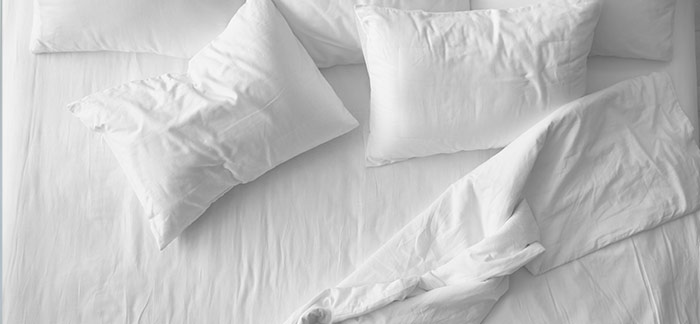|
There’s nothing quite like the feeling of finally getting into bed at the end of a long, busy and stressful day. The average adult spends 3000 hours in bed each year, and you’ll spend one third of your day (and life!) on your mattress. How would you feel, though, knowing that most of these blissful moments in bed are spent in the company of creepy little creatures? If you really knew how many things lurked under the covers, it would literally make your skin crawl.
So, what’s actually in and on your bed? Your mattress absorbs bodily fluids, dirt, dust mites (and their droppings!), fungi, mould spores, skin flakes and lingering bacteria from cold and flu viruses. Your bed might look clean, but it’s not the grime that attracts bugs – it’s the blood, carbon dioxide and warmth (they could be after you!)
|
|
Is my bed making me sick?
|
|
Do you experience any of the following symptoms in bed? General discomfort, struggling to fall or stay asleep, or breathe, itchiness, headaches, terrible neck, hip or back pain and stiffness, congestion, a sore throat, coughing, waking up fatigued, or ‘on the wrong side of the bed’, feeling irritable or moody? Your bed could be the culprit.
|
|
Why could my bed be making me unwell?
|
|
Take it from top to toe - what are your headboard, pillow, linen, mattress made of? You may be allergic to those fibres, or you’re being exposed to some chemicals your mattress and pillow have been treated with. Could something be living in the crevices of your headboard or mattress? When was the last time these were cleaned? How old is your mattress and pillow? Are you using the correct mattress and pillow to align and support your neck and spine? How often is the floor underneath your bed and your bedside table vacuumed and dusted? What bookshelves, plants, ornaments, stuffed toys, blankets and cushions are surrounding your bed? Bedbugs like hiding in clutter. Even though you may love snuggling your pet, their fur carries dander, dust, pollen, their saliva, urine, and possibly fleas.
|
|
What can I do about it?
|
 |
|
How to keep the bed allergies and bugs at bay:
- Buy a (hypoallergenic) mattress cover/protector and an anti-allergy pillow cover
- Put your pillows in the sun frequently to get some fresh, clean air. Wash your pillow protectors monthly, and change your pillow cases weekly
- Replace your pillows every 12-18 months. Not sure when it’s time to do that? Try the ‘bounce’ test by folding your pillow in half. If it doesn’t spring back into shape, it’s too old!
- Wash your bed linen (especially your sheets) weekly. Sanitize these with a bleach-based detergent, and a hot water wash followed by a tumble dry for at least 30 minutes should help to kill both the bedbugs and their eggs
- Dust and vacuum your pillows and mattress at least once a week. Remember to clean out your vacuum cleaner often too – there’s no use in using a dirty one!
- Swop your mattress sides every three months. To rotate it, lift the bottom and pull it away from the wall. Take one corner (e.g. right) and rotate your mattress left to 90 degrees so that the bottom is hanging over one end to e.g. the left side. Take the corner again (e.g. right) and slide it to the top to now be at the head of the bed. To flip it, raise the mattress on its edge and lower it over so that the other side is facing up.
- Regularly air your bed. It’s actually best not to make your bed immediately each morning, and to rather leave the sheet and duvet open so your bed can breathe
- Keep your bedroom cool and open the windows for fresh air whenever possible
- Invest in a humidifier as well as an air purifier with a HEPA (high-efficiency particulate air) filter to ensure bedroom air remains clean
- Diluting 20 drops of tea tree oil in a spray bottle and spraying it on your bed sheets is unfortunately ineffective, as undiluted tea tree oil is what kills the critters, but is harmful to you. Instead, lavender essential oil may act as a bedbug repellent. Apply some on your skin before bed and you could fall asleep easier and less afraid of being bitten
- Regularly sun your mattress and pillows
- It’s difficult to wash a mattress, so try sprinkling it with bicarbonate of soda and let it settle for 20 minutes. Use a small hand-held vacuum cleaner to remove the powder (and bugs!) Bed bugs stay hydrated through their shell’s waxy layer, and baking soda could assist in absorbing these surface fluids and dehydrating the bugs.
- The average mattress has a lifespan of 8 years, so replace it every 5-10 years
- Let your pets sleep in their own little bed on the floor next to your bed instead of on the bed. If they sleep in your room or on your bed, vacuum this every week
- When travelling, take your own clean sheets, pillows, sleeping bag and towels with you, to avoid any possible allergies from soaps, perfumes and bleach. It’s also better to leave your favourite stuffed toy at home to avoid it picking up hotel germs
|
|
The more you know, the better action you can take. There’s no harm in cleaning your bedroom and bedding more often, plus your body will benefit from a cleaner sleeping space, so fight those bed bugs and enjoy a peaceful sleep tonight!
|
|

